Travel Agents
Despite being literally rooted in place, many plants can be surprisingly mobile. When you stand in a prairie or woodland, all the plants around you are in a silent battle for territory. If one plant is weakened or removed from the community, others are quick to fill the newly available space. Neighboring plants may extend rhizomes or stolons (horizontal underground or aboveground stems, respectively) into such gaps and claim them by sinking down roots or raising new shoots. Alternatively, one or numerous seeds just waiting for an opportunity to germinate may occupy that space.
Plants also need to travel beyond their immediate neighborhood. Establishing new satellite populations across the countryside helps spread risk and ensure that one event won’t eliminate a species from an entire landscape. In addition, populations of pathogens (disease-causing organisms) and insects that attack leaves, flowers and seeds tend to build up over time. Any offspring produced right next to its parent will have to deal with those accumulated challenges. It can be advantageous for a plant to send its progeny to seek fortune in new places.
Rhizomes and stolons are great for short-distance moves, especially because new shoots can receive infusions of water and nutrients from their parents as they try to establish themselves. For longer-distance movements, though, most plants rely on seeds. Over eons, plants have developed incredibly diverse and fascinating strategies for helping their seeds get out of the immediate vicinity (typically packaged in fruits) to find opportunities elsewhere.
In its simplest form, a wildflower seed is a case for a plant embryo. The seed coat provides protection for the embryo, and most wildflower seeds also contain endosperm tissue, which provides nutrition (like a snack for the road). The primary role of a seed is to keep the embryo safe and alive until it can germinate and grow into a seedling. Another role of a seed (and its encompassing fruit), though, is to help that embryo travel — hopefully to a place where it can successfully germinate and survive.
Seed dispersal can be categorized in several ways, but most plants employ a combination of strategies. Some plants have heavy seeds that drop straight down, while others eject them forcefully some distance. Many others take advantage of wind, water or animals to carry their seeds away. Each mode of transportation requires specialization in seed or fruit architecture. Some seeds provide resources that are attractive to animals, for example, while others devote resources to the creation of elaborate feathery appendages to catch the wind.
Free Falling
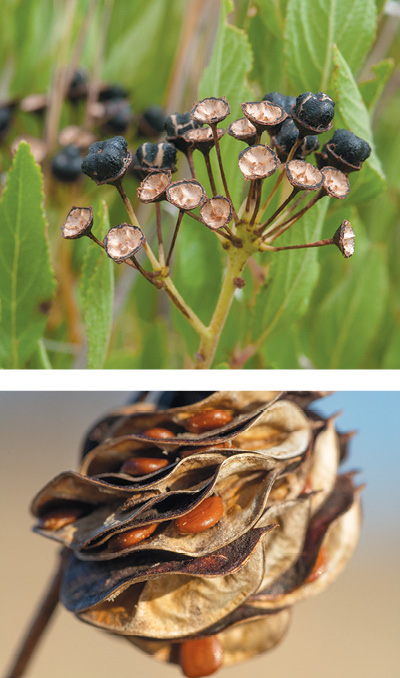
TOP The seeds and remaining launch pads, if you will, of New Jersey tea (Ceanothus americanus) are indicative of the ballistic seed dispersal strategy this plant employs. BOTTOM The dense, smooth seeds of Illinois bundleflower (Desmanthus illinoensis) fall out easily and often land right below their parent plant. PHOTOS Chris Helzer
Plants that rely on gravity to transport their seeds often create heavy fruits or seeds that fall right below the parent plant. Illinois bundleflower (Desmanthus illinoensis), for example, creates dense, smooth seeds that tend to land directly beneath the pod they emerge from. The relatively big seeds of spiderworts (Tradescantia spp.) act similarly, though they are less dense and smooth than those of bundleflower. When the large, heavy fruits of osage orange (Maclura pomifera) fall from the tree, they also tend to stay where they land.
Other plants can actually launch seeds into the air to send them a little farther away. That kind of ballistic seed dispersal happens when the fruit containing the seed dries out and constricts in a way that eventually forcefully expels the seed. Members of the Ceanothus genus — including New Jersey tea (C. americanus), buckbrush (C. cuneatus) and feltleaf (C. arboreus) — and violets (Viola spp.) are examples of ballistic seed dispersers.
However, neither gravity nor drying fruit move seeds very far, so plants employing those strategies may have a secondary option. Violet seeds, for example, are produced with a small fleshy appendage called an elaiosome, which is full of lipids and proteins. After being ejected from its pod, a seed might travel up to several feet away before landing. However, its elaiosome may then attract foraging ants, which carry the seed back to their nest. The ants feed the highly nutritious elaiosome to their larvae and then deposit the remainder of the seed (still intact) in the nest’s “compost pile.” There, the high nutrient levels provide a particularly favorable place for the seed to germinate and grow.
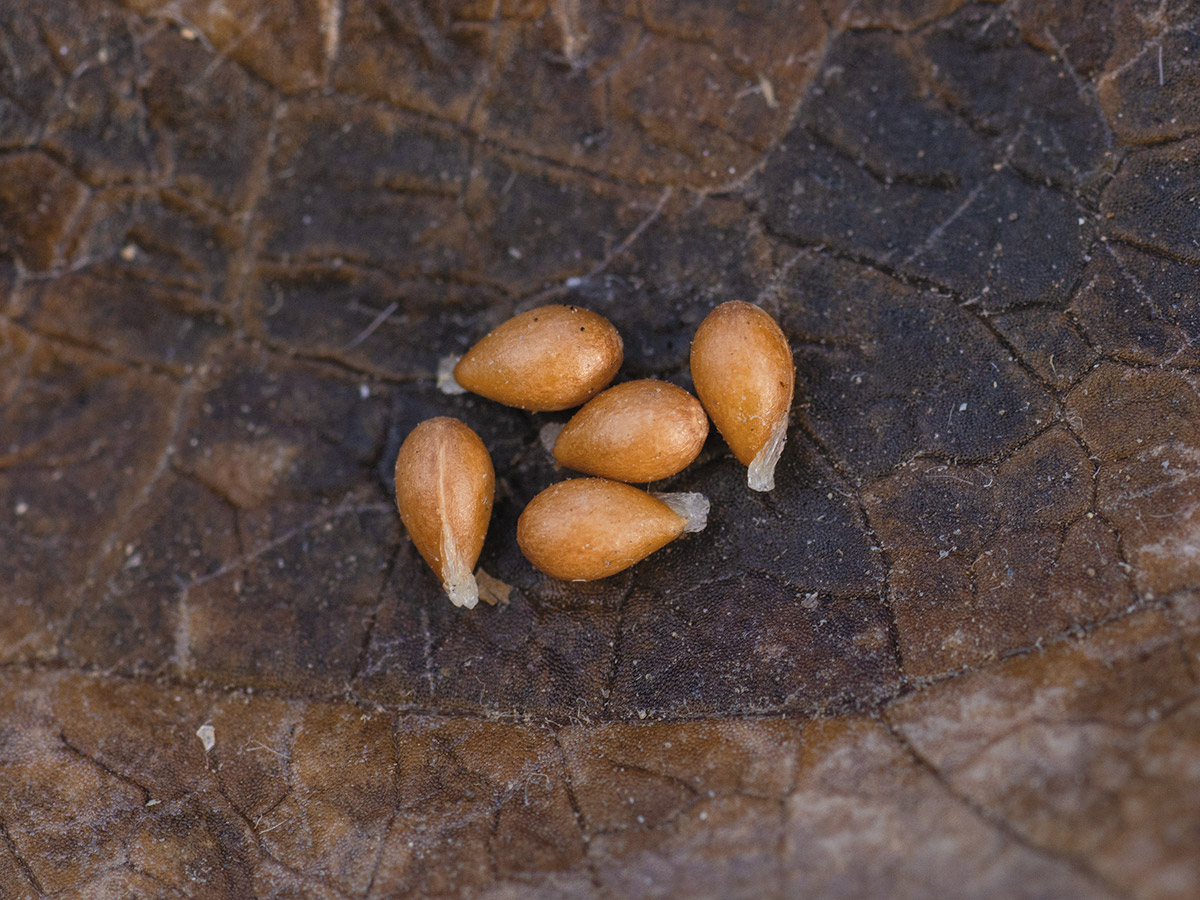
On these prairie violet (Viola pedatifda) seeds, it’s easy to see the fleshy elaiosomes, which contain lipids and proteins that encourage seed movement by ants. PHOTO Chris Helzer
Osage orange fruits don’t appear to be popular as food for wildlife, and their weight keeps them from being easily carried off. As a result, their fruits don’t often travel far from the tree. That doesn’t seem like a very effective dispersal strategy, but scientists have proposed that osage orange may have evolved with large Pleistocene mammals such as mastadons, horses, giant sloths or camels, that could have eaten and dispersed their seeds. Experiments have shown that osage orange seeds don’t survive passage through horses, but they can remain intact through elephants, so the hypothesis is at least possible.
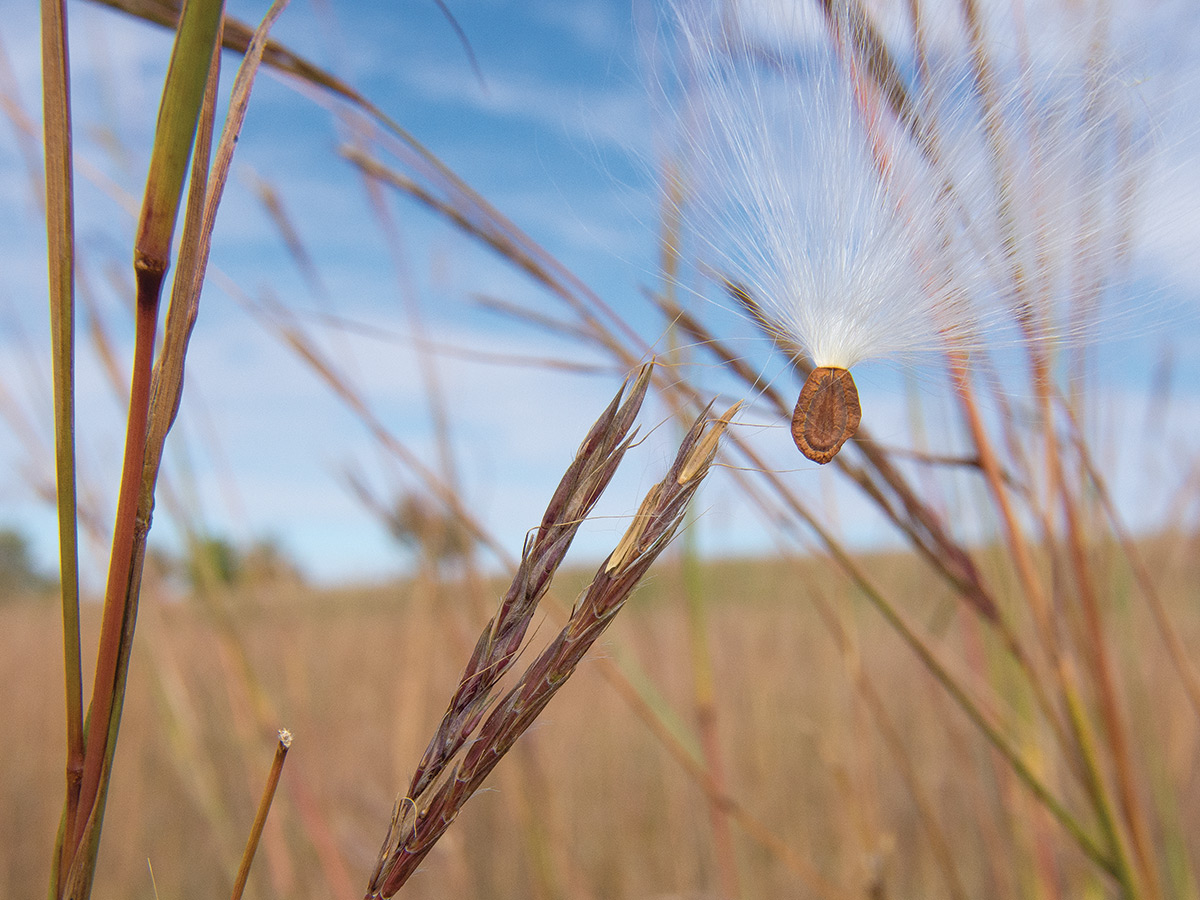
A seed from common milkweed (Asclepias syriaca) rides on its pappus, or parachutelike fluff, en route to new ground and, hopefully, germination. PHOTO Chris Helzer
Windswept
Some plants rely on wind to carry their seeds for them. Wind-dispersed seeds often have noticeable appendages that help them catch a breeze. Most of us have picked up and blown the seeds of a dandelion. Those seeds each have a feathery pappus, common among numerous other wildflowers, that allows them to float gracefully along on a light breeze. Most of these seeds travel only a short distance before they get hung up on nearby plants or fall to the ground, but a lucky few may get lifted high into the air, allowing them to ride air currents for many miles. Asters, thistles, milkweeds and many other “fluffy-seeded” plants use the wind to carry their seeds.
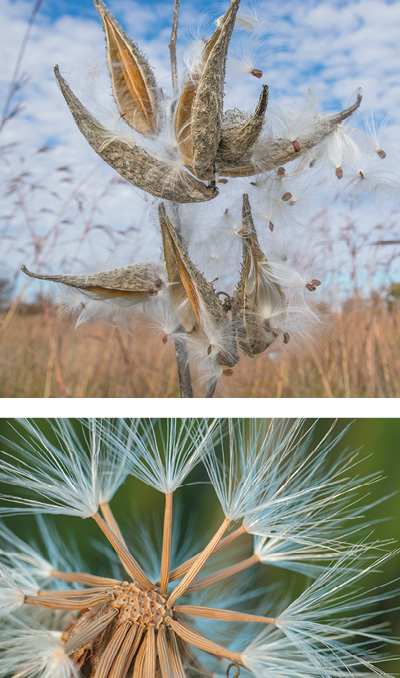
TOP The follicles (what we might call pods) of this common milkweed (Asclepias syriaca) are a great example of dehiscent fruit, which break open to disperse seeds. BOTTOM This prairie false dandelion (Nothocalais cuspidata) seed head begs to be blown on, by wind or humans. PHOTOS Chris Helzer
While wind can be a great vector for long-distance transport, there are trade-offs for plants that use this strategy. If a wind-dispersed seed is going to travel by breeze, the seed has to be fairly lightweight. As a result, many wind-dispersed seeds are lacking a hard seed coat or a supply of endosperm. This reduces their weight but also their longevity and, thus, viability. While some seeds can germinate after many years of lying dormant, most wind-dispersed seeds need to germinate within a few months — or less — before their embryos die.
Go With the Flow
Plants that grow in or near streams, ponds or other water bodies often take advantage of water as a transport mechanism. These species tend to create either fruits or seeds that can float — sometimes for many months. Marsh marigolds (Caltha spp.), water plantains (Alisma spp.) and arrowheads (Sagittaria spp.) are all examples of wetland plants with floating seeds. Texas bluebells (Eustoma exaltatum ssp. russellianum) and other members of the Eustoma genus also have seeds that float and can be carried and deposited by moving water.
Employing water transport can be an efficient strategy for plants that are restricted to wet habitats because it helps ensure seeds are deposited in the kind of habitats they like best. On the other hand, if a plant is living in a small pond, the distance it can float is pretty limited. Similarly, seeds dropped from plants growing along stream banks can only float downstream. It can be advantageous for a plant growing along a pond or stream to send some of its seeds to a different pond or stream. Accordingly, many wetland plants have seeds that are buoyant, but that can also be carried by wind or animals.
Hitchin’ a Ride
Animals are also popular agents for moving seeds around a landscape. Transport by animal is generally accomplished in one of two ways: Plants either create seeds that can hook on to unwitting passersby or pack nutritious ingredients into their seeds (or fruits) to entice creatures to eat them.
Hitchhiking seeds are well known to anyone who spends much time outside. These are the seeds we have to scrape off our clothing and pets after a hike. Most tag-along seeds have some kind of hook attached to them, which helps them adhere to anything that brushes past. Depending on the creature and how far it might travel, some hitchhiking seeds may end up miles away before they are scraped off or otherwise fall from the host.
There are numerous ways seeds can adhere to animals. Some, such as beggar-ticks (Bidens spp.), have a couple of large hooks that catch on fur or other parts of an animal. Others, like tick trefoils (Desmodium spp.) have countless tiny hooks that look and act like miniature versions of the Velcro hook-and-loop fastening system. Countless other designs exist to help seeds of various species snag a passing animal. There’s a good chance you can find an example on one of your socks, pant legs or pets right now.
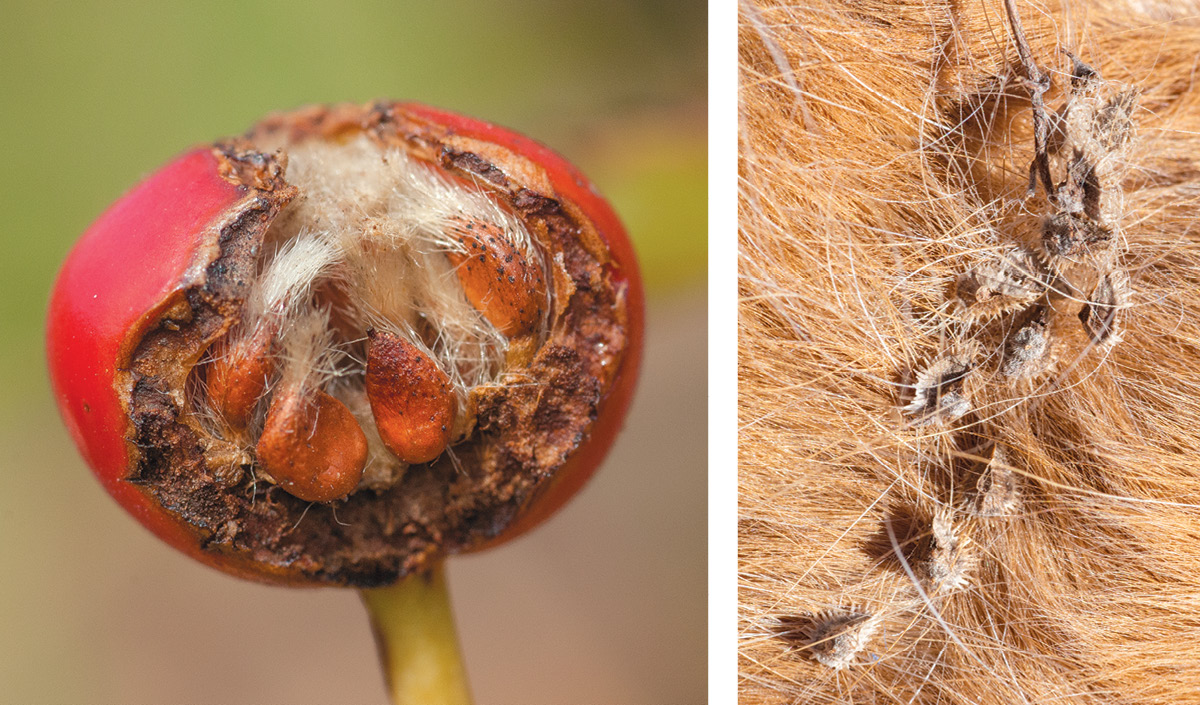
LEFT This fruit from a prairie rose (Rosa arkansana) shows evidence of enticing hungry creatures. RIGHT Hackelia species (often called beggar’s- lice or stickseeds) commonly transport seeds in the fur of animals; here, a dog was the unknowing chauffeur. PHOTOS Chris Helzer
Of course, another way to travel via animal is to be eaten and then deposited after a trip through the digestive tract. One way plants attract hungry animals is by embedding their seeds inside tasty and nutritious fruits. When an animal consumes the fruit, the seed goes with it, and hopefully survives the digestion process and comes out intact. In fact, for some seeds, a trip through an animal’s digestive system can help break down their seed coat and stimulate germination.
Not all plants rely on tasty fruits to get animals to ingest their seeds. They may make the seeds themselves appetizing. The nutrition provided by a seed’s endosperm to its embryo can also nourish a hungry bird or mouse. This can be a risky strategy for plants, though. The animal only gains value from the seed if it can digest it, but if the seed is fully digested, the plant loses.
Even if they lose many of their seeds to digestion, plants may still get what they need from the transaction if an animal carries some seeds away to eat in a safer location or store for later. Anything that delays ingestion means a seed might be dropped or forgotten about before it’s actually eaten. In the case of seeds stored for long periods of time, the animal that cached it might not survive long enough to consume it.
The design of some seeds can help encourage animals to carry them away before eating them. For example, some sunflower seeds are encased within a shell that can take time to crack open. Rather than taking the time to open shells and eat each seed while exposed to predators on top of a tall plant, many animals prefer to take sunflower seeds to a safer place before prying the shells apart. Not all the seeds that are carried away actually get eaten, and those few survivors have a chance to grow in a new location.
Risky Business
While long-distance seed dispersal plays an important role in the reproduction of plant species, it is also an incredibly risky endeavor. The chances of an individual seed surviving its trip and then landing in a place where it can successfully germinate and become established are incalculably low. The vast majority of seeds never make it. They get eaten, desiccated, consumed by fungus, or otherwise destroyed long before they have the opportunity to become seedlings.
Perennial plants spread that risk over many years. They can produce a moderate number of seeds each year, and even take years off if conditions aren’t optimal for flowering and seed production. After all, a parent needs to generate only one successful offspring before it dies to continue its genetic line.
Annuals and biennials, on the other hand, get a single shot at flowering and seed production before they die. Because they flower only once, at least one of their seeds has to successfully grow and produce its own seeds to ensure the survival of the family lineage. As a result, annuals tend to produce huge numbers of seeds, especially compared to their perennial counterparts.
Regardless of how many seeds are released into the world by a plant in a given year, it’s still incredible that any survive and become mature plants. Consider what needs to happen for a seed to find success: First, a seed needs to land where it can come in direct contact with the soil. In most places, the soil is pretty well covered by other plants and plant parts, living and dead. If a seed manages to find the soil, it still needs to get the right combination of light and moisture to trigger its germination before the embryo runs out of nutrients or the seed is found and consumed by an animal or fungus. Assuming it manages to germinate, the last step is to compete with any surrounding plants, most of which are probably already well established and well prepared for that fight.
When you put all those hazards together, it’s a wonder that any seed ever survives and grows up to produce its own offspring. However, the fact that plants put so much energy into such a dicey investment shows how important it is. Based on the number of plants in the world today, it appears the strategy
is working.
Chris Helzer is the Nature Conservancy’s director of science in Nebraska. He is founder of The Prairie Ecologist blog and author of two books: “The Ecology and Management of Prairies in the Central United States” and “Hidden Prairie: Photographing Life in One Square Meter.”
Seed Banking at the Center
Did you know the Wildflower Center has its own seed bank? This is where we store seeds collected from wild populations of native Texas species. Seeds of secure species are available to scientists for many types of research (e.g., climate change, phylogeny, restoration), while seeds of vulnerable species are stored as a hedge against extinction.
We do this because pressures on native plant species change over time, and it’s not always possible to conserve plants in their natural habitats. Seeds of many wildflowers and grasses, on the other hand, remain viable for decades if processed and stored correctly. It’s an efficient and cost-effective means of insuring that ecotypes of native plants are available for research and conservation.
That said, it takes a dedicated team of volunteers — as well as cooperation from private landowners — to collect seeds from wild populations, process them for storage, and test their viability. Minnette Marr, curator of the Center’s seed bank, says she lets nature guide her on where and what to collect: “I can focus my efforts any given year on the species that are having a good year and banking those seeds for later use,” she says. The Center’s bank currently houses seeds from 478 native plant species. – A.M.
Learn more at wildflower.org/project/seedbank.
